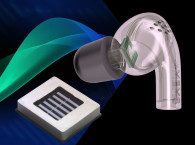
This cooperation between USound and Luxshare-ICT meets the already identified demand for applications that leverage the recognized benefits of MEMS microspeaker technology - including potential massive scale economies and consistencies - while still accommodating active noise cancelation, transparency, augmentation, and adaptive technology innovations. The joint innovation is an integrated dual-driver module that is optimized for true wireless stereo (TWS) earbuds.
The new integrated solution module was named Gemini after the Latin word for "twins," although showcasing the use of two non-identical combined transducers. The core of the innovation is the integration of USound's Conamara MEMS tweeter inside a toroidal electrodynamic woofer, creating a 2-way system. Aside from the two loudspeakers, the Gemini module also includes USound's ASIC amplifier, Tarvos 1.0, custom designed for the company's MEMS drivers.
To further optimize product build and simplify manufacturing, the Gemini module also integrates an inward-facing microphone that is ready for feedback-ANC, plus a combined input for all signals (in and out) with an FPC board-to-board connector. To improve acoustic integration, the Gemini dual driver uses a sound tube element designed to bring the tweeter signal directly to the earbud output, avoiding detrimental resonances.

According to USound, the Gemini dual driver offers a multitude of advantages, starting with the fact that each transducer element can be tightly optimized for a specific frequency range, where the dynamic driver (woofer) can be designed with a more flexible diaphragm, improving the sound pressure level (SPL) in high-leakage scenarios. While this would result in a loss of SPL at high frequencies, this is compensated by USound’s Conamara UA-C0601-2T MEMS tweeter. Without the need to produce SPL at low frequencies, the MEMS tweeter is able to achieve ideal performance at high frequencies, extending well above 20kHz for translation of high resolution audio (HRA) sources.
More important are the implications for ANC, augmentation, and adaptive audio. Since the woofer in this dual driver configuration only needs to reproduce low and mid frequencies, it can be designed with lower acoustic impedance, yielding better performance in high-leak scenarios. This makes it ideal for high-performance noise cancellation. USound knows (as well as all other MEMS microspeaker manufacturers) that effective noise cancellation applications require very high SPL levels on the lower frequencies - something that so far MEMS microspeakers have not been able to deliver. Nevertheless the combination in hybrid dual driver setups has demonstrated to be more effective, maximizing the possibilities of the traditional dynamic driver.
As Jakob Spötl, the leader of the acoustic development team at USound explains, "While it would not be technically correct to claim that an added tweeter will improve the ANC itself directly, it allows for more flexibility in improving and optimizing the woofer for the task. Generally speaking, active noise canceling capabilities place a quite high demand on speakers. For example, the requirement for high excursion becomes more grave when ANC is used, as the earphone system needs to be able to compensate for the large amount of controlled leakage necessary to ensure stable performance over repeated inserts of the earphone into the ear. With the requirement of having the highest excursions possible, sacrifices in the high-frequency reproduction are necessary. In other words: a speaker that can do it all (the high excursion for ANC and the precision required for properly creating the high frequencies) is tough to design and produce consistently."
"Splitting this requirement up into a woofer speaker covering the high excursion demand and a tweeter, which can subsequently be optimized for the high frequencies, gives a lot of advantages. It will bring manufacturers closer to achieving their desired sound profile," Spötl adds.
Detailing the specifications achieved in the Gemini module, USound says that the generous 12.5mm (half-inch) diameter of the dynamic element from Luxshare-ICT is able to deliver a very high SPL output - 130dB to 120dB in the critical 20-200Hz range - ideal for ANC applications and able to cancel out even very loud impulse noises. (See measurements below)

The thickness of the module is also greatly reduced, and the electronic design is also simpler by having all the I/O of the module on a single board-to-board connector as well. This mechanical factors are also important in earbuds that use ANC, where the design is vital to help achieve controlled leakage and the path is integrated, connecting the acoustic volume to the outside. The Gemini 12.5 mm dynamic driver delivers the necessary headroom to deliver undistorted sound pressure even in challenging conditions, and the integration with the Tarvos 1 amplifier facilitates integration between the MEMS transducer and the dynamic driver.
Another very important argument for this integrated module is the flexibility for design differentiation - a critical factor in current product developments in the extremely competitive true wireless segment. The Gemini module offers legitimate opportunities to differentiate new products, starting with the possibilities to customize sound profiles, which can selected by the users according to their usage preferences, without degrading the performance in fundamental parameters, and much less variability between production drivers.
USound and Luxshare are promoting demonstrations of the dual driver audio module to manufacturers, while the Gemini audio module is undergoing the final stages of development.
www.luxshare-ict.com
www.usound.com








